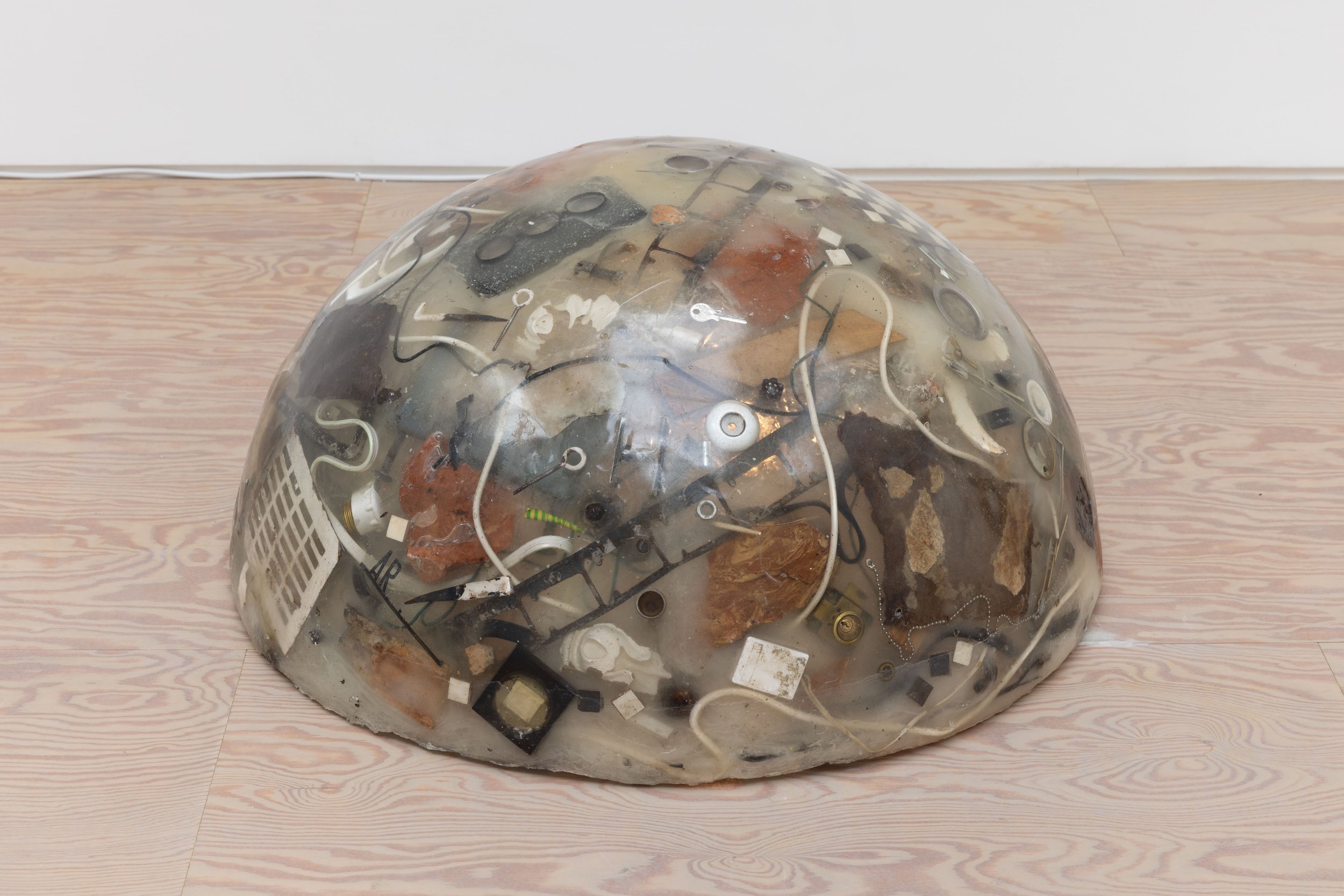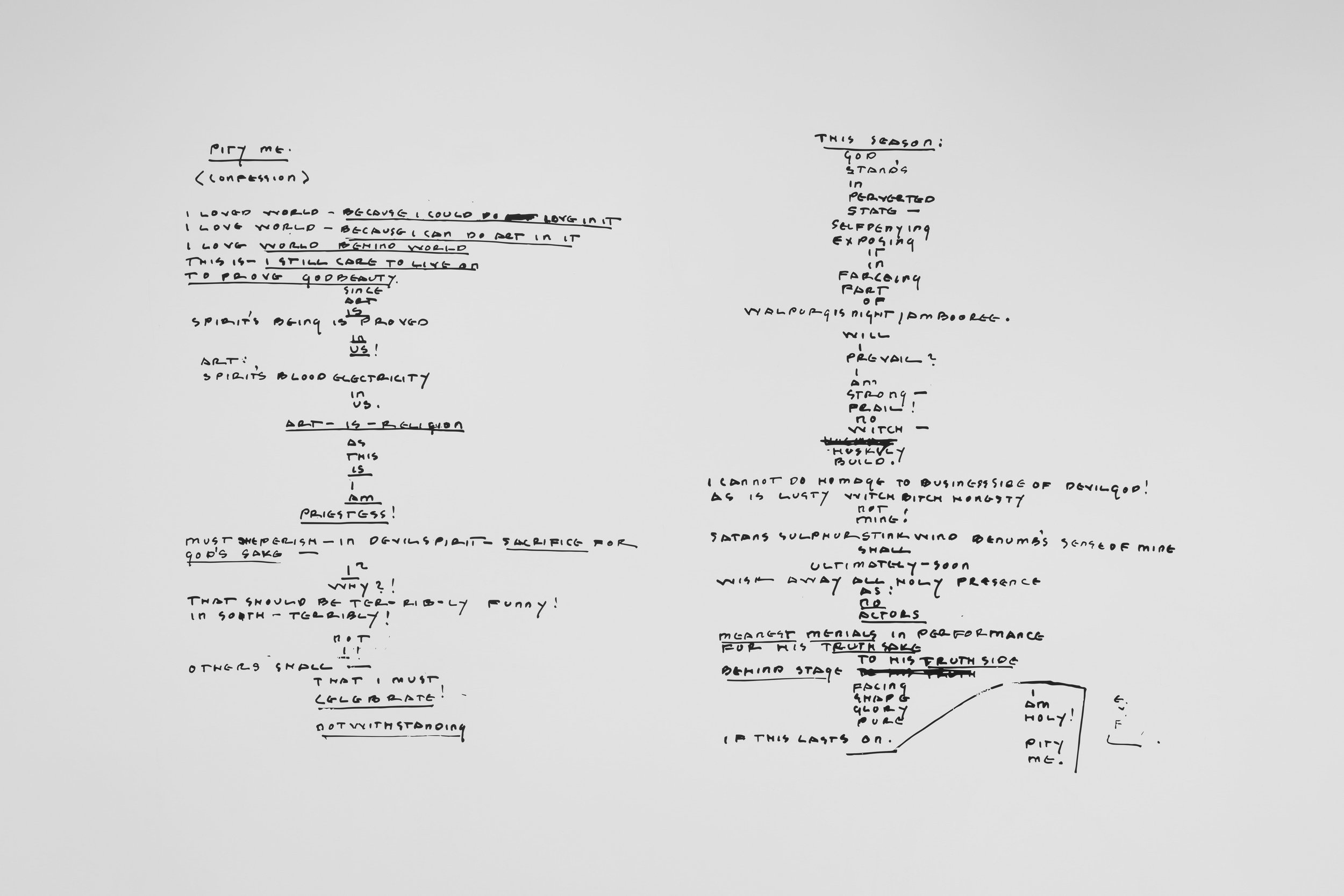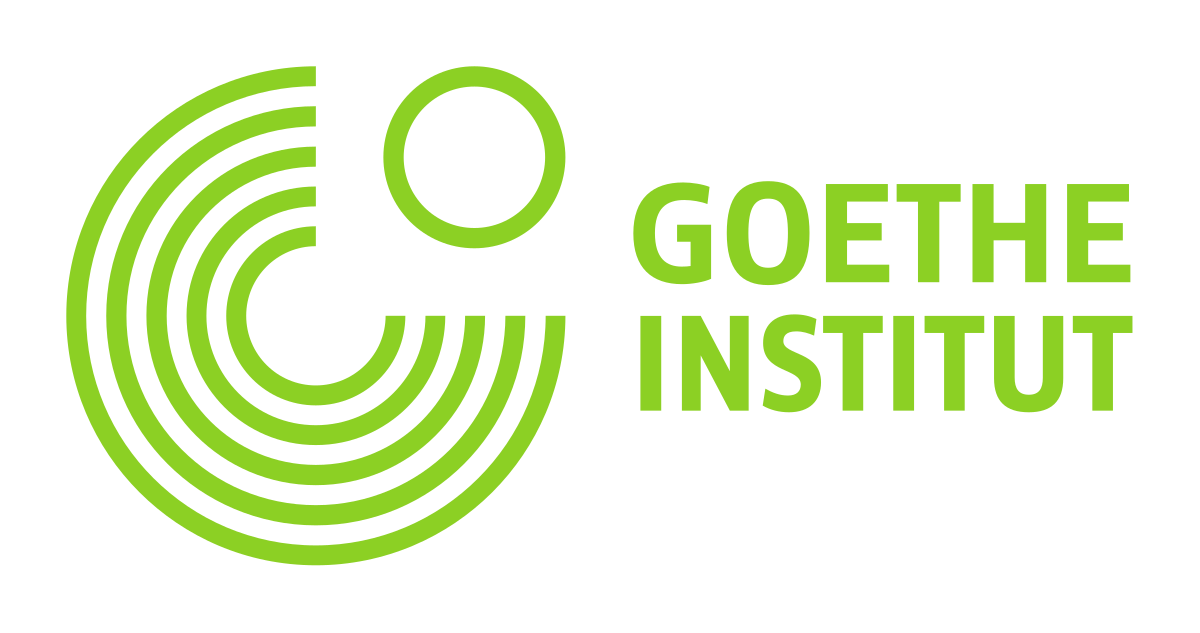The Baroness
27 May - 17 September 2022
Wednesdays to Saturdays, 12-6pm
A group exhibition dedicated to Dada artist, the Baroness Elsa von Freytag-Loringhoven (1874–1927), alongside contributions by Nora Gomringer, Libby Heaney, Caspar Heinemann, Istanbul Queer Art Collective, Zuzanna Janin, Reba Maybury, Sadie Murdoch, Nat Raha, Taqralik Partridge, Liv Schulman, Astrid Seme, and Linda Stupart.
Read press release here.
Read artworks descriptions here.
Listen to audio description of a selection of key artworks here (mp3 19mb).
Baroness Von Freytag-Loringhoven (Between ca. 1920 and ca. 1925).
© George Grantham Bain Collection, Prints & Photographs Division, Library of Congress.
“I have a strangely rough and powerful voice, and when I read with feeling my reading is very good – excellent – not like a stage performance.” - Elsa Von Freytag-Loringhoven in her letters to Anon, 1924–1926.
“Ah, the Baroness Else Von Freytag-Loringhoven, with huge rings on her ten fingers, and her dog Sophie in her lap, is reciting her Dada poetry in another room. The walls shake, the ceiling rocks, life is real and life is earnest!” - Mike Gold, coeditor of Liberator magazine, 1921
“She wore a trailing blue-green dress and a peacock fan. One side of her face was decorated with a cancelled postage stamp (two-cent American, pink). Her lips were painted black, her face powder was yellow. She wore the top of a coal scuttle for a hat, strapped on under her chin like a helmet. Two mustard spoons at the side gave the effect of feathers.” - Margaret Anderson, founder and editor of The Little Review magazine, 1921
Mimosa House presents a group exhibition dedicated to Dada artist, the Baroness Elsa von Freytag-Loringhoven (1874–1927). The Baroness features von Freytag-Loringhoven’s rare original artworks and manuscript reproductions of poems, alongside contributions by international contemporary artists and poets: Nora Gomringer, Libby Heaney, Caspar Heinemann, Istanbul Queer Art Collective, Zuzanna Janin, Reba Maybury, Sadie Murdoch, Nat Raha, Taqralik Partridge, Liv Schulman, Astrid Seme and Linda Stupart.
The Baroness Elsa von Freytag-Loringhoven was “the first American Dada”, “New York’s first punk persona”, “the great aunt of feminist performance art”, and a radical poet and assemblage artist. Born in Germany in 1874 as Else Plötz, the future Baroness Elsa von Freytag-Loringhoven left home at age 18 to work as an erotic vaudeville artist and an artist’s model in Berlin and Munich. She then relocated to New York and Paris to pursue her poetical and performative practice, which she brought into everyday life.
Grotesque, provocative, non-compliant, eccentric, anarchic – the Baroness’ work shared the vocabulary of Dada, an art movement formed as a reaction to the First World War. However by including her own body and personal motives in her work, the Baroness created a distinct interpretation of Dada and produced some of the first readymade sculptures in 1913. Her sculptures and costumes included teaspoons, tin cans, an iron ring found on the street and a birdcage with a live canary. Her visual poetry touched on the subjects of gender and sexuality, religion and war, disrupting patriarchal and gender codes, and reclaiming women’s right to emancipation and pleasure.
Despite its radicality and innovation, the Baroness’ work remains unfamiliar to the wider public. In dialogue with contemporary artists and poets, this group exhibition presents her original works in the UK for the first time, celebrating her revolutionary vision and impact on our understanding of gender and feminism today.
Generously supported by Arts Council England, Austrian Cultural Forum London, Fluxus Art Projects, Goethe-Institut London, Hallett Independent and High Commission of Canada in the UK.
Featured artists also include:
Libby Heaney’s two screen moving image artwork Euro(re)vision (2019), where Libby performs as two topical EU government leaders from March 2019, Angela Merkel and Theresa May reciting absurd machine generated songs. Inspired by Dada poetry, such as Hugo Ball’s sound poem ‘o gadji beri bimba’, this piece uses multiple cutting-edge machine learning/artificial intelligence techniques to create new forms of algorithmic poetry and performance.
The Polish artist Zuzanna Janin’s sculptures-collages Femmage a Maria & Elsa, (for....) (from 2018 - ongoing), are awarded to the laureats of the Maria Anto & Elsa von Freytag-Loringhoven Art Prize, established in Warsaw. Works from the series of Home Transformed Into Geometric Solids (2018) use the waste from Janin’s family house construction to connect with memories of Elsa von Freytag- Loringhoven and her birth town of Swinemünde (Świnoujście) located in today’s Poland.
Reba Maybury’s video sculpture A-good-individual (2019) shows the backs of five different body parts of five different submissive men reading poems in Reba’s apartment at different times during August 2019. The poems each submissive reads had been made for Reba on her demand, using the cut up technique, from abuse she received during a right wing media storm about her work as a ‘political dominatrix’.
In her work Pass-Way Into Where-To (2021), Sadie Murdoch immerses herself in the photographs, poems and manifestoes of Elsa von Freytag-Loringhoven. The artist’s intent is to re-route and re-position the history of the New York and Zurich Dada movement by cutting up and re-assembling poems and manifestos, placing them alongside reconfigurations of photographic archives.
Inuk artist Taqralik Partridge’s Build My Own Home (2021) features amautiit (women’s parkas) decorated with spoons collected on a visit to Scotland - where her grandparents are from - as a nod to Elsa von Freytag-Loringhoven’s Dada fashions created from everyday objects. Her use of teaspoons as decoration also speaks to the history of colonial trade and intercultural exchange.
French-Argentine artist Liv Schulman’s six-episode fiction Le Goubernement (2019) imagines the destiny and work of women, lesbian, queer, trans and non-binary artists who lived in Paris from 1910 – 1980. Elsa von Freytag-Loringhoven, who moved to Paris in 1926, is one of the artists that were erased from the great Twentieth Century modernist narrative.
Austrian artist Astrid Seme’s works form an homage to Elsa von Freytag-Loringhoven and her manic use of em dashes. In an enlarged form and with a typesetter’s manner, Astrid hands her vinyl dashes Baroness Elsa’s em dashes (2019) over to the curator to link, emphasize, intervene and interrupt the different exhibited works. The purpose of the em (or en) dash is wide-ranging —as an appropriation of silence, as acting dissonance, as interruption, as occupying space.
Linda Stupart’s new site-specific installation rhymes with the Baroness Elsa von Freytag-Loringhoven’s Cathedral (1918), a readymade sculpture formed of a found wood fragment, also featured in the show. At Mimosa House, Linda will build a sister-cathedral constituted of rescued pieces of wood. In the artists’ own words, the piece was produced through: “walking the River Cole in Birmingham near my home since 2019; a public/private path encountered semi naked; clothing constituted from rags and found or stolen plants. Collecting skins; limbs; cathedral-fragments of the riverbank, which is threatening to burst; like I am, like we are”.
The Baroness exhibition is curated by Daria Khan, with support from Carleton University Art Gallery, Ottawa and Owens Art Gallery, Sackville.
Assistant Curators: Angela Blanc and Sandra Lam
Production Manager: Divya Osbon
For press enquiries, please contact info@mimosahouse.co.uk
With generous support from Arts Council England, Austrian Cultural Forum London, Fluxus Art Projects, Goethe-Institut London, Hallett Independent and High Commission of Canada in the UK.
About the artists:
Elsa von Freytag-Loringhoven (b. 1874, Swinemunde, Germany - 1924, Paris, France)
Elsa von Freytag-Loringhoven, “the Baroness” as she was known, became a living legend in the bohemian enclave of New York City's Greenwich Village in the years before and after World War I. A provocateur and essential catalyst for New York's burgeoning Dada movement, the Baroness obliterated the boundaries of conventional norms of womanhood and femininity and upended notions of what was considered art. Elsa von Freytag-Loringhoven received two posthumous retrospectives at Francis M. Naumann Fine Art, NY (2002); and at Cabaret Voltaire, Zurich and Berlin’s Literaturhaus, Berlin (2005).
Nora Gomringer (b. 1980, Neunkirchen, Germany)
Nora-Eugenie Gomringer is a German and Swiss poet and writer. She has won a number of awards, including the 2013 Literaturpreis des Kulturkreises der deutschen Wirtschaft, the 2015 Ingeborg-Bachmann-Preis and the Carl Zuckmayer Medal by Rhineland-Palatinate. She lives in Bamberg, where she has been directing the International House of Artists Villa Concordia, a cultural institution founded by the State of Bavaria, since 2010. Her most lyrical work appears under the name Nora Gomringer, published by Voland & Quist. Hydra's Heads, a collection of her work translated into English by Annie Rutherford, appeared with Burning Eye Books in 2018.
Libby Heaney (b. Tamworth, UK)
Libby’s post-disciplinary art practice includes moving image works, performances and participatory & interactive experiences that span quantum computing, virtual reality, AI and installation. Libby’s practice uses humour, surrealism and nonsense to subvert the capitalist appropriation of technology, the endless categoriziations and control of humans and non-humans alike. Instead, Heaney uses tools like machine learning and quantum computing against their 'proper' use, to undo biases and to forge new expressions of collective identity and belonging with each other and the world.
Caspar Heinemann (b. 1994, London, United Kingdom)
Caspar’s practice spans sculpture, poetry, essay, drawing, and theatre. Caspar’s work is concerned with the politics of land, occultism, folk revivalism, and sexual countercultures. Caspar is interested in the formal qualities of earnestness, brattiness, obliqueness, religiosity, generosity, and rattan furniture. Caspar’s solo exhibitions have been held at Cell Project Space, London; Outpost Gallery, Norwich; Almanac, London; and Kevin Space, Vienna. Caspar has a forthcoming solo exhibition with Cabinet, London in 2022. Caspar makes theatre in collaboration with Alex Margo Arden, and his first poetry collection Novelty Theory was published in 2019 by The 87 Press.
Istanbul Queer Art Collective
Istanbul Queer Art Collective was founded in 2012 to engage in live art, with a view that the documentation of performance is an art form in itself. The collective is currently based in London and is comprised of its two founding members Tuna Erdem and Seda Ergul, who are firm believers in what Jack Halberstam calls the “queer art of failure” and what Renate Lorenz calls “radical drag”. Their performances range from the durational to the intimate and can morph towards other forms like sound art or installation. IQAC has performed at various art events around the world among which are: House of Wisdom Exhibition in Amsterdam and Nottingham; If Independent Film Festival and Mamut Art Fair in Istanbul, Athens Sound Acts Festival in Greece, Zürcher Theatre Spektakel and Les Belles de Nuit in Zurich and Deep Trash, Queer Migrant Takeover and NSA: Queer Salon in London.
Zuzanna Janin (b. 1961, Warsaw, Poland)
Zuzanna creates sculptures, photographic objects, drawings, and video and sound installations. In the years 1980-87, she studied at the Academy of Fine Arts in Warsaw, and she now lives and works in the city. The main theme and the most important point of reference in the works of Zuzanna is the artist herself. The artist draws inspiration from her emotional biography, memories transformed by time, body memory and its relationship to the environment. In this way, she builds “a gradually evolving image of human life and the human condition”. Zuzanna took part in Sydney Biennial 1992, Istanbul Biennial 1992, Soonsbeek’93, Liverpool Biennial 1996 and 54th Venice Biennale 2011 (in the official programme of Romania). She participated in a shows at Foksal Gallery, Warsaw, Whitechapel London, RSA Edinburgh, MCA Chicago, Jeu de Paume Paris, Staatliche Sammlung Dresden, Museum of Contemporary Art Chicago, Kunstmuseum Bern, Hamburger Bahnhof Berlin, TOP Museum Tokyo, National Museum Krakow and Warsaw. Kunsthalle Wien, MAM Rio de Janeiro, Hoffmann Sammlung Berlin.
Reba Maybury (b. 1990, Oxford, United Kingdom)
Reba is an artist, writer and political dominatrix sometimes working under the name Mistress Rebecca. Her work explores the tension between her perceived strength as an object of transactional fantasy and how, through the reality of sex work, she turns this power into something tangible. Much of her art practice is physically created by her submissions through her direction as a way to further the complicated imbalances of labour under sex work and attempt to empower her further than the men’s desires, leaving her with more than just a payment from them. Themes of capital, gender, labour, sexuality and transaction are essential themes to her practice.
Sadie Murdoch (b. 1965, Hexham, United Kingdom)
Sadie studied at Chelsea College of Art and Design and Leeds Metropolitan University. She was a student on the Whitney Museum of American Art Independent Study Programme, New York from 2003-2004, and an Abbey Rome Scholar at the British School at Rome in 2002. Sadie’s solo exhibition in 2016, SSS-MM, at the Museum Haus Konstruktiv in Zürich, was accompanied by her artist book Omnipulsepunslide, published by Artphilein Editions. She has staged other one-person exhibitions at the Henry Moore Institute, Leeds (2007), the Agency, London (2008 and 2011), and the Henry Peacock Gallery and Domobaal, London (2002). Her performance at Belmacz with Abbas Zahedi and Toby Upton, A Case of Med(dling)tation, was included in Performance Exchange, in 2021. Sadie is currently lecturer, MFA Fine Art at Goldsmiths College and lives and works in London.
Dr Nat Raha
Nat is a poet, and queer / trans* activist-scholar, based in Edinburgh, Scotland. Her research addresses sexuality and gender, critical theory and Marxism, contemporary poetry and poetics, through creative and critical methods. She is a postdoctoral researcher on the ‘Life Support’ project at University of St Andrews, and was a postdoctoral researcher on the ‘Cruising the Seventies: Unearthing pre-HIV/AIDS queer sexual cultures’ project at the Edinburgh College of Art. In 2018, she completed her PhD thesis ‘Queer Capital: Marxism in queer theory and post-1950 poetics’ at the University of Sussex. Her current research also investigates radical transfeminism, race in UK poetry and poetics, and queer and trans print cultures.
Taqralik Partridge (b. 1975, Montréal/Québec, Canada)
Taqralik is an artist, writer, spoken word poet and curator originally from Kuujjuaq, Nunavut. She is the Director of the Nordic Lab at Galerie SAW Gallery in Ottawa. Taqralik’s visual art has been exhibited nationally and internationally, including at Leonard and Bina Ellen Art Gallery (Montreal) and the Biennale of Sydney. She co-curated Tunirrusiangit (2018) at the Art Gallery of Ontario and Qautamaat | Every day / everyday at the Art Gallery of Guelph (2020). Her performance work has been featured on CBC Radio One and she has toured with the Montreal Symphony Orchestra under Kent Nagano and with Les Productions Troublemakers. Taqralik’s writing focuses on both life in the North and in southern urban centres, as well as the experiences of Inuit people. A collection of her poetry, curved against the hull of a peterhead, was published in 2020.
Liv Schulman (b. 1985, Buenos Aires, Argentina)
Through the constant use of writing in her video works and live performances, Liv’s work centres on how language affects individual and social bodies. The written word or a formulated dialog is always the starting point. Producing filmed discourse, she shows the effect that material and immaterial economies have on all of us. Liv studied art practice and art writing at the ENSAPC de Paris-Cergy, the Goldsmiths University of London, and the Lyon Post-Diploma. She is the winner of the 20th Prix Fondation d’entreprise Ricard, awarded on the occasion of the exhibition, curated by Neïl Beloufa in September 2018. Liv now lives and works in Paris.
Astrid Seme (b. 1985, Graz, Austria)
Astrid is a graphic designer and runs her own studio in Vienna. She received her M.A. at Werkplaats Typografie (NL) after graduating from the University for Applied Arts Vienna. Rooted within the fields of graphic design and typography her practice also spreads into sound-based works. These projects are focused on dissecting discrepancies in form and content between the written and spoken word. She also co-runs Mark Pezinger Books, a publishing house for artists’ books.
Linda Stupart (b. 1983, Cape Town, South Africa)
Linda Stupart is an artist, writer, and educator from Cape Town, South Africa. They completed their PhD at Goldsmiths in 2016, with a project engaged in new considerations of objectification and abjection. They are interested in the possibilities for writing and making discrete grounded encounters with different kinds of bodies (of knowledge, objects, affect as well as corporeal bodies) as a way to think through less alienated ways of living and thinking together. This comes out of encounters with feminist art, postcolonial, ecological, queer, and affect theory as well as embodied and object-based critical institutional encounters. Their current work consists predominately of writing, performance, film, and sculpture, and engages with queer theory, science fiction, environmental crises, magic, language, desire, and revenge. In 2021 they had a major exhibition following a residency at Wysing Arts Centre, and then a harrowing, with Carl Gent and Kelechi Anachua. In 2019 they produced All Us Girls Have been Dead for so Long with Carl Gent for the ICA London; a play about climate change, queer sex, and Ecco the Dolphin.


















































